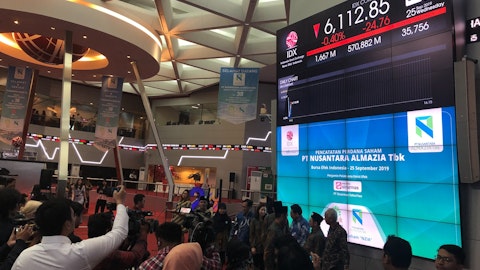Manulife Financial Corporation (NYSE:MFC) Q3 2023 Earnings Call Transcript November 9, 2023
Operator: Please standby. Your meeting is ready to begin. Please be advised that this conference call is being recorded. Good morning, ladies and gentleman. Welcome to the Manulife Third Quarter 2023 Financial Results Conference Call. I would like to turn the meeting over to Mr. Hung Ko. Please go ahead Mr. Ko.
Hung Ko: Thank you. Welcome to Manulife’s earnings conference call to discuss our third quarter and year-to-date 2023 financial and operating results. Our earnings materials, including the webcast slides for today’s call, are available on the Investor Relations section of our website at manulife.com. Turning to slide 4. We will begin today’s presentation with an overview of our third quarter results and strategic update by Roy Gori, our President and Chief Executive Officer. Following Roy’s remarks, Colin Simpson, our Chief Financial Officer, will discuss the company’s financial and operating results. After the prepared remarks, we’ll move to the live Q&A portion of the call. [Operator Instructions]. Before we start, please refer to slide 2 for a caution on forward-looking statements.
Note there are material factors or assumptions applied to making forward-looking statements, and actual results may differ materially from what is stated. I would also refer you to slide 35 for a note on the non-GAAP and other financial measures used in this presentation, which includes an explanation of our use of transitional results for 2022 comparison. With that, I’d like to turn the call over to Roy Gori, our President and Chief Executive Officer. Roy?
Roy Gori: Thanks, Hung. And thank you, everyone, for joining us today. Yesterday, we announced our third quarter 2023 financial results. Let me first share with you some quick thoughts on the quarter. We delivered growth across our global business, which is evidenced through the strong operating and new business results. In the third quarter, we saw double-digit growth in APE sales and new business value compared with the prior year quarter. We also generated solid growth in new business CSM of 6%, which contributed to an annualized organic CSM growth of 5% on a year-to-date basis. Since the adoption of IFRS 17, we’ve been delivering steady year-on-year growth in core earnings over the past three quarters, including a 35% rise in core EPS this quarter.
We also reported core ROE of 16.8%, ahead of our medium term target of 15% plus for the second consecutive quarter. And we continue to focus on allocating capital to our high return businesses to drive ROE growth. Despite the impacts of the challenging macroeconomic environment on our net income, we grew our IFRS 17 adjusted book value by over $1 per share in the third quarter, which translated to a 4% increase year-on-year. And finally, enabled by our strong capital position, we continued to deploy capital to further enhance returns to shareholders through dividends and share buybacks. Turning to slide 7, we are driving profitable growth, while focusing on the needs of our customers and returning capital to our shareholders, which contributed to a strong third quarter.
Asia continued to build on the momentum of the previous quarter, capitalizing on the return of demand from Mainland Chinese visitor customers, and delivered strong new business results, with APE sales and new business CSM growth of 20% and 16% year-on-year, respectively. In Canada, we delivered impressive APE sales growth of 51% compared with the prior-year quarter, driven by a large affinity market sale, and it translated into an increase in new business value of 72% in the segment. We’re also making decisions easier for our customers. Notably to accelerate the growth of our global high net worth business. We launched a unified onboarding platform in the third quarter in Bermuda, Hong Kong and Singapore to deliver a consistent high touch experience for both distributors and customers.
I’m encouraged by the continued growth across our global franchise. Now let me speak to our continued journey of becoming a digital customer leader and highlight some of the key initiatives across our businesses. Starting with Canada, we continued our digitization efforts to meet growing demand for more personalized digital health care experiences for our group benefits members, with a strategic partnership with League, a leading healthcare technology provider. This partnership will help our customers understand their health, focus on prevention, access care, and better understand and optimize their benefits. In global WAM, we accelerated customer adoption of digital applications in Canada retirement through our Say Goodbye to Paper campaign, which contributed to a 165% increase in members converting to e-statements over the three month campaign period and an increase in satisfaction in their digital experience over the prior quarter.
Moving to Asia, we further automated our claims handling process in Hong Kong to deliver a better customer experience and drive operational efficiency. Through continued leveraging of data to enhance our auto adjudication engine, the initiative drove a nearly two fold increase in straight through processed claims year-on-year. In the US, we continued to optimize our digital capabilities to create a more seamless digital customer experience through various initiatives, including an enhancement of the interactive voice response authentication, enabling 31% of inbound calls to be completed with no human interaction during the quarter. These are just a few recent examples of how we’re making decisions easier for our customers and meeting their personalized digital needs and part of our investment of more than $1 billion since 2017 to digitize our business.
Looking ahead, we’ll continue to build on our strong digital platform while accelerating our adoption of new technologies such as generative AI. We’re already piloting a number of initiatives that we will look to scale as we uncover their potential to generate top and bottom line benefits. Moving to capital management, we continue to maintain a strong capital position supported by a higher LICAT ratio in the quarter of 137%. We also generated stable growth in adjusted book value per share with a 4% increase year-on-year in the third quarter. Coupled with a financial leverage ratio that is close to our medium term target of 25%, we are in a position of strength to weather the macroeconomic uncertainties and continue returning capital to our shareholders.
In fact, we’ve returned approximately $7.7 billion of capital to our shareholders through dividends and share buybacks since we resumed our share buyback program in 2022. And our dividend per common share has grown an average of 10% annually since 2017. In summary, I’m pleased with our strong results in the third quarter. While we continue to operate in a tough and uncertain environment that presents challenges, I see tremendous opportunities against the backdrop of higher rates and continued recovery in Asia. Manulife is uniquely positioned to capture these opportunities, given our financial strength, business and geographic diversity and a leading insurance business that will continue to benefit from higher rates. Thank you. I’ll now hand it over to Colin to review the highlights of our financial results.
Colin?
Colin Simpson : Thanks, Roy. We have indeed delivered strong performance in the third quarter with growth in sales, earnings, book value and capital. I’ll go into a little more detail on our results before we move to Q&A. I’ll start with our top line on slide 9. APE sales increased 21% from the prior quarter as we continue to capitalize on the return of demand across Asia, in particular Hong Kong. In Canada, we delivered APE sales growth of 51%, driven by a large affinity market sale. The strong growth in sales translated into an increase in new business value of 15% and contributed solid growth in new business CSM of 6%. This reflects increases in sales of Asia and Canada, offsetting a decrease in the US, which experienced a slowdown in demand for accumulation products.

Global WAM saw net outflows of $800 million entirely due to a large case pension plan redemption in our US retirement business. Year-to-date, we’ve generated net inflows of $5.8 billion. I’m encouraged by the continued growth across our new business metrics compared to 2022 in the face of relatively difficult economic conditions, a testament to the demographic tailwinds in many of our markets, our broad product offering and our ability to execute. Moving to slide 10, which shows the strong growth in our profit metrics. Core EPS increased 35% as we grew core earnings and bought back shares. Now, this growth was flattened by the hurricane related charge in our P&C reinsurance business in the prior-year quarter. But normalizing for this, core EPS still increased 12% despite a significantly higher credit charge.
As Roy mentioned, active capital allocation is a key priority for us and it is encouraging to see our third quarter core ROE increase to 16.8% ahead of our medium term target of 15% plus for the second consecutive quarter. Turning to slide 11, our net income was lower than core earnings this quarter caused by the challenging investment environment, but it is important to consider that some of this adverse result was offset by gains in other comprehensive income, or OCI, which contributed to the increase in our book value. Together with the contractual service margin, which also increased, we reported an adjusted book value per share of $30.67, up 4% year-on-year. Bringing back to our core earnings results, slide 12 shows our drivers of earnings analysis presented relative to the prior-year quarter to give you a sense of our progress.
The first point to note is the recovery in the core net insurance service result. This was driven by the non-repeat of last year’s $256 million hurricane charge, but also improved insurance expense. The second point is that higher interest rates continue to benefit our net investment result through both higher expected investment earnings and higher returns on our surplus assets. These two factors were partially offset by high debt costs included another core earnings, along with higher performance related costs and investments in technology across our businesses. Finally, the increase in expected credit loss, or ECL, this quarter was primarily related to certain electric utility bonds impacted by the Hawaii wildfires and a handful of private placement loans.
These factors drove a 28% year-on-year increase in our core earnings as shown in the next slide, which I’ll move to and discuss on non-core items. The challenging macroeconomic environment led to $1 billion market experience net charge in the third quarter. This included a $400 million charge from lower-than-expected returns on ALDA, a $273 million charge due to lower-than-expected public equity returns during the quarter and the $266 million loss in derivatives and hedge accounting ineffectiveness, driven by the significant increase in rates and steepening of yield curves where the 10 and 30-year rates increased more than 70 basis points while the shorter rates between 1 and 5 years rose on average 30 basis points. We will continue to refine our hedge accounting programs to better align with economic hedges.
I will also note that, given the interaction between the fair value through OCI option on our assets and liabilities and derivative hedge accounting, it will be important to look at the impact on this line in conjunction with movements in OCI to see the full picture of interest rate impacts. For this quarter, the impact was net favorable. While we reported a net charge in ALDA reflecting lower than expected returns, the portfolio continued to generate a positive return in the quarter. Our long term track record supports our ALDA return assumptions, but we should expect some periods such as now where it may underperform the long term assumptions. Commercial real estate was again the biggest driver of our ALDA underperformance as higher long term risk free rates are pressuring valuations.
Although higher capitalization rates used by third party appraisers lowered current valuations, these higher rates also indicate higher returns going forward, which further increases our confidence in achieving our long term assumptions prospectively over time. It is important to reiterate that we continue to view a diversified ALDA portfolio as well suited for insurance liabilities, with attractive returns and lower volatility relative to both credit and equity indices over the medium to long time horizon. Outside of the market experiences, I would like to note that our annual review of actuarial methods and assumptions or basis change had a net neutral impact on net income attributed to shareholders. This year’s basis change resulted in a net favorable impact of $347 million pretax, reflecting a neutral impact to net income and increases in OCI and CSM.
Further information on basis change is available in the appendix to the presentation. Lastly, the $306 million gain in reinsurance transactions, tax related items and other reflects a one-off release of multi-year tax provisions. The next few slides will cover the segment view of our results starting with Asia on slide 14. Both top and bottom line performances were strong. APE sales increased 20% from the prior-year quarter, reflecting a return of demand from mainland Chinese visitor customers, which you can see in our Hong Kong results. As we have mentioned previously, the pace of economic recovery in Asia is uneven and the strength of our diversified business in the region continued to shine through. The increase in sales contributed to a 16% and 7% growth in new business CSM and new business value respectively.
We delivered strong core earnings growth in Asia of 33% year-on-year, primarily driven by higher investment yields and business growth as well as product actions. But I would add that core earnings also benefited from an increase in amortization of CSM in our Hong Kong business as a result of the bases change. Moving over to the Global WAM segment results on slide 15. Our Global WAM business reported net outflows of $800 million. This was driven entirely by a large case pension plan redemption in US retirement, which more than offset continued strong inflows in our institutional business. Excluding this large case pension plan, net inflows were $4 billion for the quarter. Retail net outflows in the quarter reflected lower demand as investors continued to favor short term cash and money market instruments amid market volatility and higher interest rates.
Despite this backdrop, our US retail net flows outperformed the industry average. Our Global WAM business also delivered resilient core earnings supported by higher average AUMA, which increased 4% year-on-year and higher than usual institutional performance fees. Our core EBITDA margin of 26.9% has improved sequentially since the first quarter of 2023, driven by steady growth in average AUMA and higher institutional performance fees. Heading over to our Canada segment on slide 16, which had another strong quarter, APE sales increased 51% compared with the prior-year quarter, primarily due to a large affinity market sale, which was the main contributor to our significant growth in new business value. I would like to remind you that the majority of the affinity market sales are classified as premium allocation approach, or PAA, contracts which do not generate CSM.
Cor earnings increased by 4% compared to the prior-year quarter, mostly driven by more favorable insurance experience in our group benefits business. Moving to slide 17 which illustrates our US segment’s results. In the US, lower APE sales were driven by the backdrop of a continued high rate environment, adversely impacting our accumulation insurance products in particular, especially for our affluent customers. Lower sales contributed to the lower new business results. We’re actively broadening our product base to mitigate the headwinds, including the recent expansion into the employer market by introducing a multi life product. Our US business delivered resilient core earnings which decreased 2% compared to the prior-year quarter, mainly reflecting the increase in ECL.
Insurance experience improved year-on-year from net favorable claims experience, which provided a partial offset to the credit impact. On to slide 18. We continue to maintain a strong balance sheet and capital position. This underpins the commitment we made to our customers with every policy solving gives us financial flexibility. At the end of the quarter, we had $22 billion of capital above our supervisory target ratio, and our higher LICAT ratio of 137% remains strong. Our financial leverage ratio declined by 0.6 percentage points year-on-year, largely driven by higher adjusted book value during the quarter, and this continued to track closer to our medium term target of 25%. Enabled by our strong capital position, we continue to return capital to shareholders.
We’ve returned approximately $7.7 billion of capital to shareholders through dividends and share buybacks since we resumed our buyback program in 2022, including approximately $420 million of buybacks or nearly 1% of our outstanding common shares during the third quarter. And finally, moving to slide 19, which shows how we’re tracking against some medium term targets. Our CSM growth metrics are below our medium term targets, partly due to the impacts of market and foreign exchange movements. We continue to explore products and business enhancements to improve CSM growth, and are still optimizing our performance in a post IFRS 17 world. Our core EPS growth and core ROE have been strong in the first nine months of 2023 and above our target ranges.
All in, we’ve delivered strong operating and new business results. And echoing Roy’s earlier remarks, as we continue to face an uncertain global macroeconomic and geopolitical environment, I’m confident that we are well positioned to deliver for our customers, shareholders and colleagues. This concludes our prepared remarks. Before we move to the Q&A session, I would like to remind each participant to adhere to a limit of two questions, including follow-ups and to requeue if they have additional questions. Operator, we will now open the call to questions.
See also Top 20 Diamond Producing Countries in the World and Top 20 Gold Mining Companies in the World.
Q&A Session
Follow Manulife Financial Corp (NYSE:MFC)
Follow Manulife Financial Corp (NYSE:MFC)
Operator: [Operator Instructions]. And the first question is from Meny Grauman from Scotiabank.
Meny Grauman: Your WAM business benefited from higher than normal performance fees in institutional business. I was hoping you could provide us a little bit more color in terms of what was driving that. And I was wondering if you could scale that in terms of dollars.
Paul Lorentz: It’s Paul here. Yeah, in the quarter, we did have a strong performance fee. It was on our timber business. The performance fee was $23 million post tax this quarter that helped contribute to the positive results. But if you look at the underlying core earnings, they were strong without the performance fee. If you compare them to Q2, if I back out the performance fee completely, core earnings would have been $338 million, up 6% from Q2, EBITDA margin would have been 25.6%, which is 100 basis points up from Q2 and that’s relative to average AUMA up 1% from Q2. Now, having said that, performance fees can be lumpy, but we would expect to generate a certain level on a regular basis. Historically, for us, that – over the last four years, that’s been between on average $10 million to $15 million post tax on a 12 month basis.
This year, year-to-date, we’re sitting at $27 million post tax, a little bit higher than normal. But if you’re trying to get a sense of run rate, you should include some portion of performance fees on an ongoing basis.
Meny Grauman: Just wanted to talk about CSM. New business CSM growth and CSM balanced growth both year-to-date coming in well below medium term targets. So just wanted to revisit that what’s driving that? And then trying to think through the implications in terms of earnings and book value growth going forward? So those would be the two questions on CSM.
Colin Simpson: It’s Colin here. We’re actually really pleased with our new business CSM growth in the quarter. 80% is coming from Asia, and Asia is up 16% year-on-year. So there’s good momentum coming from Asia and that will feed through into the CSM balanced growth. If you look at the CSM balanced growth in the quarter, on an organic basis, it’s up 5% annualized, that’s year-to-date, actually, annualized 5%. So we have got momentum in our CSM balanced growth. It isn’t quite at the 8% to 10% target that we’re going for. But we’re very focused on this because, as you know, this is our store of future earnings and this will drive through into future earnings. So really nothing new to say on our target. We continue to operate in an IFRS 17 environment, and there’s only three quarters of reporting. So, we’re still getting used to that as a reporting regime, but remain very confident on our medium term targets
Roy Gori: I might just add in as well. I think Colin summarized it well. But we’re still very much committed to our medium term targets for both new business CSM and CSM. Obviously, we’re still in the early days of IFRS 17. And it’s a challenging environment, as Colin highlighted. But there’s a lot for us to be encouraged by, particularly the fact that our new business CSM for Asia was 16% in the quarter and 12% year-to-date. And as Colin highlighted, more than 70% – in fact, 80% of our new business CSM is coming from Asia. So we still feel very confident in our medium term targets, which are through the cycle. And there’s a lot to be optimistic about as we look to the next year and beyond
Meny Grauman: Just a follow-up in terms of – obviously, you’re reacting to a market environment, but is there anything – any levers that you can pull internally in order to boost those growth numbers? So curious about actions that you can take or are taking to do them?
Roy Gori: I think, Meny, for us, it’s really about more customers through the door, more sales and better margin. If we get that taken care of, then everything else flows from there. So that’s really what we’re focused on.
Operator: The next question from Doug Young from Desjardins Capital Markets.
Doug Young: Just maybe starting with Asia. It looks like there was – lapse was an issue again in Vietnam. I think that’s been the case for a few quarters now. Can you maybe delve into a bit of what the issue is and the reserves need to be adjusted on that business? And then, I guess on the flip side, in Asia, it also looks like there was some negative claims experience. And taking this from just slide 25, if you can kind of dig into that a little bit, what drove that?
Philip Witherington: This is Phil, I’ll make a start and then hand over to Steve Finch who may wish to comment further. But to your first point on Vietnam, the market has been experiencing challenges. And we’ve referenced this in previous quarters. But it really is a reflection of the underlying challenging economic conditions in Vietnam. And we’re seeing that translate into lower new business volumes, but also lower levels of persistency. And when you look at the movement in policyholder experience in the CSM, that’s really a reflection almost in its entirety of the challenging persistency that the entire industry is seeing in Vietnam and where we’re seeing that as well in our business. You also referenced policyholder experience or experience elsewhere.
And in the P&L, you do see a negative $20 million in Asia. I do want to clarify that that exclusively relates to maintenance expenses. So our policyholder experience, there are positives and negatives across the region, but it all balances out to a net neutral position. And when you look at the impact of expenses and compare the overall expense position relative to the third quarter of 2022, what you’ll notice is there’s been a reallocation of unattributed expenses to maintenance expenses. So that $20 million is actually geography rather than a deterioration in the expense position. But I will hand over to Steve to see if he wants to comment further particularly on the balance sheet impact.
Steven Finch: And also adding the claims was neutral for Asia across the region overall. Specifically, Doug, with respect to your question on reserving, as Phil noted, the persistency challenge across the industry in Vietnam, that’s expected to be short term in nature. We don’t think it’s a structural issue when we’ve got a strong position there. So it’s not really a long term assumption balance sheet issue. And that’s why it’s not reflected in the basis change.
Doug Young: Steve, while I’ve got you, just on the long term care insurance, I know it was a net modest positive, exactly like last quarter, a little negative in the P&L, a little positive in the CSM. Can you unpack a bit about what’s going on to the P&L, walk through the CSM? What you’re seeing, is it exactly the same as last quarter? And is this something that we should expect to continue for this block of business where we see a little drag in earnings, but a little bump in CSM, just trying to understand how to think about the moving pieces with this business?
Steven Finch: On long term care, in total, which is really how I think we need to look at it at experience to understand the drivers, LPC was a modest positive. It’s also been a modest positive, since the assumption review in in 2022. And just take the chance to emphasize, you know how we’ve been managing this business over time, regularly updating to reflect experience, and we’ve been doing that for a couple of decades. Whereas under the new US GAAP standards, that’s a new requirement. So we’ve been managing it that way for years. In terms of specifically what’s going on in the quarter, what goes through the through net income is cash variances. So it’s higher utilization for customers on claim, but that’s more than offset by favorable incidents and termination experience. And that particular trend is likely to continue over the short term, but, again, I look at the experience in aggregate, which has been positive.




